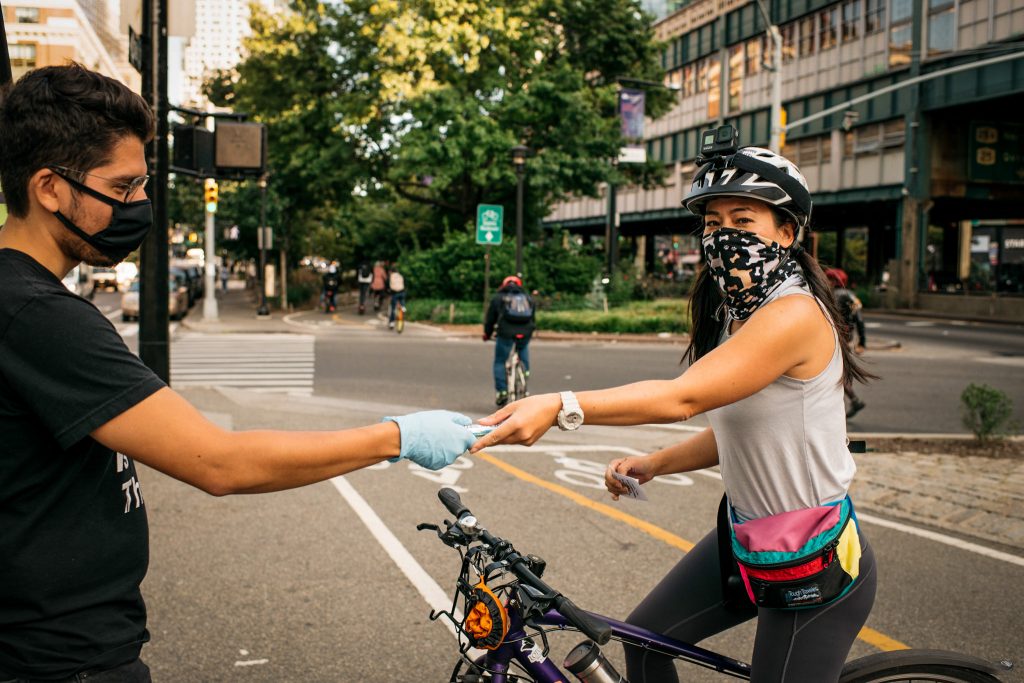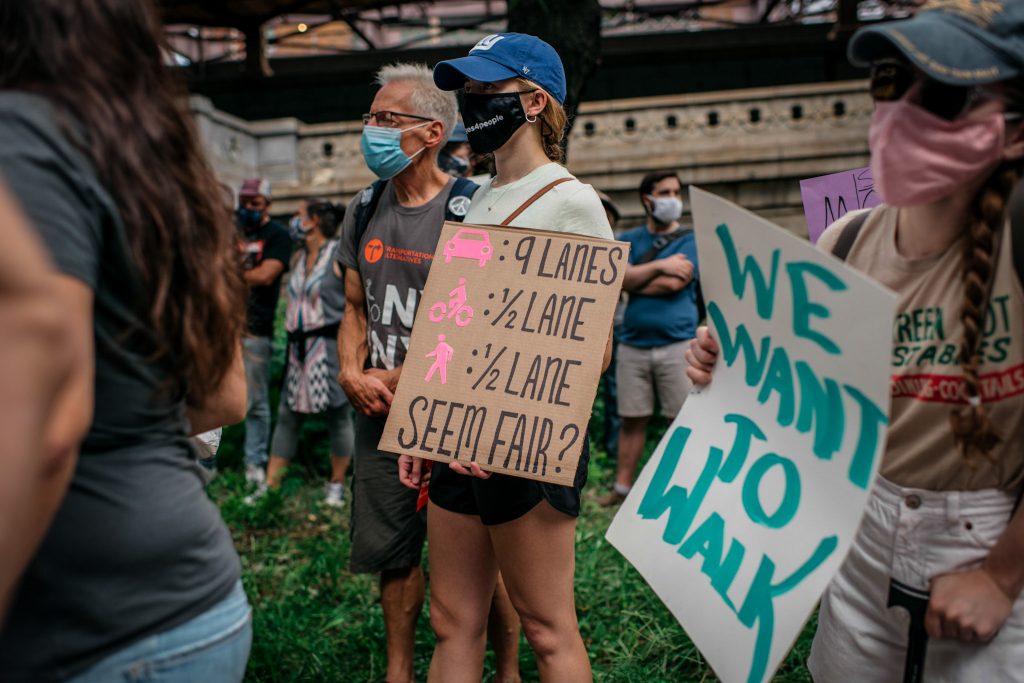When you think of New York, what is the first thing that comes to your mind? Cycling is probably not on top of your list. It seems dangerous, especially for outsiders, but this is starting to change thanks to the incredible and hard work of New York’s cycling advocates.
New York City is famous worldwide for its skyscrapers, Broadway, and yellow cabs, but many people don’t know much about cycling in the megacity. While the pandemic affected cycling culture in New York similar to many other cities, with people turning to bicycles in need of an alternative to public transit, there’s still work to be done with the city’s cycling infrastructure.
According to a report by the bicycle advocacy group PeopleForBikes, New York City is, in fact, one of the best places to cycle in the US – but only in two of the five boroughs, Manhattan and Brooklyn. In the other boroughs, cycling is unsafe, and fatalities of cyclists are rapidly increasing. The further from Manhattan you go, the less bike infrastructure there is.
“Certain streets don’t get redesigned until someone gets killed on them.”
Juan Restrepo
“That’s a retrograde way of looking at street redesign, it’s not preventative”, Juan Restrepo, Queens Organizer for Transportation Alternative, states.
However, with Bill de Blasio’s election as Mayor in November 2013, a new political will has taken hold of New York City. The Vision Zero Programme was put into place in 2014, a programme to make the streets of New York City safe and free of road deaths and traffic fatalities by 2024.
And indeed, in the last few years within the De Blasio legislature, some crucial changes have been done. This is all happening thanks to the decade-long work of cycling advocacy groups. We had the pleasure to talk to Juan about New York’s prospects of becoming a cycling city, cycling advocacy and the importance of grassroots campaigns.
Starting Out as Radicals, Now Becoming Mainstream
Juan works for Transportation Alternative, a non-profit organisation advocating for better cycling infrastructure, based in New York City. The organisation has been in operation for more than 40 years now, which is remarkable, considering that back when the organisation started, cycling was absolutely not considered mainstream in America. Even more so, some of the ideas of the cycling advocates were degraded as radical.
Some of the most recent, notable victories of the organisation include eliminating cars from iconic New York City Parks. Central Park only became permanently car-free in 2018 – cars were previously allowed limited access during specific time frames. The same goes for Prospect Park in Brooklyn, where cars were finally banned at the beginning of 2018.
Iconic Victory on Brooklyn and Queensboro Bridge
The biggest wins recently, especially for Juan as he was part of that campaign, concern two of the most iconic bridges of New York City, Queensboro and Brooklyn Bridge. The New York City administration plans on turning one car lane each into bike lanes to provide more space for pedestrians and cyclists.
This is the result of decades of work by advocates, and the pandemic might have been the oil they needed to finally light the fire. Often enough, policymakers try to create more space for cyclists instead of limiting space for cars. In this case, people “convinced and lobbied our city government to more equitably distribute the road space on the bridge instead, which is much more cost-effective and quickly implemented.”
Juan is convinced that the pandemic made people see the importance of space for walking and biking. This step is a phenomenal win for New York’s cyclists, “it’s incredible, you have to see how bad some of the spaces we’re talking about are, to understand why it’s so important that it’s happening now as opposed to a few years from now.”
Are you wondering how they achieved this victory? Well, preparation is one big part of it. As the bridges connect two different parts of the city, different elected officials had to be targeted for this campaign. “It’s almost like two different universes politically.”
To ensure political support on both sides, Transportation Alternative gathered as much backing from the borough’s citizens as possible. Before even presenting ideas and talking to the elected officials, they assembled groups of volunteers “out there hustling, volunteering, creating events and strategies”, determined to make this project happen. “We wanted to make sure that we were presenting them with a package that was very compelling.”
Power of Grassroots Approaches
Grassroot approaches are all about achieving change by working as locally as possible – a key factor in New York City. Partly, this is due to the size of NYC: As the largest city in the US, with more than 8 million inhabitants, the five different boroughs are essentially five different universes. To achieve change, Transportation Alternative has different community organisers in all boroughs who then organise a network of volunteers within the borough. This takes a substantial amount of organising: You need representation from an organisational level, someone like Juan, “and you need strong volunteers who have a lot of people skills to go to local community meetings.”
To help you understand the concept, Juan describes it as a pyramid of representation: a paid person at the top, followed by core leaders of volunteers and then another level of volunteers, not as engaged at the other core volunteers but still committed to certain regards of the cause.
The main benefit of grassroots approaches is that local voices are getting heard, and organisations can appear larger than expected. “We want to seem like a bigger organisation, to the point where sometimes nobody knows who the paid person is. You need to seem like a bigger beast than you actually are.”
Every Day, We’re Hustling
New Yorkers, by default, are very busy people. This means that on the one hand, someone on the sidewalk screams at you for walking too slow, but in the cycling community, it means a lot of people hustling on the streets like crazy for better infrastructure.
Juan actually compares the dynamic of New York and its hustlers to old times in America where Carnival shows were still a thing. People would advertise new attractions with much fervour in their voice, effortlessly drawing attention onto them. Similarly, when you advocate for cycling on New York’s streets, “you have to have a little bit of that theatricalness”.

The volunteers of Transportation Alternative are out on the streets they would like to redesign, showing people what it could look like. This is how Juan got involved in cycling advocacy: “A random person just called out to me from the sidewalk to sign a petition for safer infrastructure. And I thought it was the coolest thing ever, the people actively on the streets and talking about this.”
Despite the lack of sufficient cycling infrastructure in New York City, the citizens are momentous in solving these issues and bringing awareness to others: “There is such a large constituency of people who are working in many different aspects to make it better.” They don’t just talk, they do.
Vision for the Future
Still, cycling advocates in New York City are one thing in particular: frustrated. Juan is convinced that New York City has so much potential for cycling, and while being frustrated, New Yorkers also love their city and will continue doing the necessary work. Optimistically and enthusiastic, Juan believes that “we’re on track to eventually get there. We still have some work to do.”
If it were up to Juan, future policies in New York City must include mandatory bike racks at bus stops, as a lot more people from the outer boroughs would consider biking daily in combination with a bus trip. In general, New York City needs much more protected bike lanes, especially in the outer areas. These things might not seem like a big deal, but for New York cyclists, small changes can mean big improvements for their daily commute.
Advice for CityChangers
It took years of work for the policymakers to redistribute the space on Brooklyn Bridge to create more space for cyclists. Being a cycling advocate in New York or any other megacity that is built for cars is tiring, but after years in the advocacy work, Juan knows: “As long as you’re thinking strategically about these campaigns and target politicians right, you’ll get there. It might take longer, but we eventually got there. And we’ve got this amazing victory over iconic bridges through hard work and lobbying the right folks and keeping this a continuing issue.”
“Whatever you’re working on, you’ll eventually get there as well.”
For every success Juan and Transportation Alternative can celebrate, they will continue their work and start new campaigns to make New York City the cycling city it is destined to be. Rest assured: No matter the state of your city’s infrastructure, if you find determined people – and you will – change can be driven from the bottom-up!
Check out this TED Talk held by Janette Sadik-Khan, former transportation commissioner of New York City, to hear more about projects that reshaped street life in New York City.




